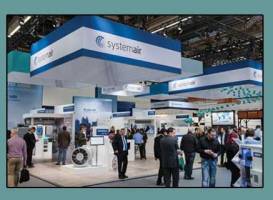Good Air Quality Pays Off
01 Mar 2019

International market leaders and leading technology companies to focus on indoor air quality, digital heating technology and the IoT, in relation to building automation at ISH.
People spend more than 80 per cent of their time in closed rooms at home, in the workplace, fitness studio, cinema, restaurant or other institutions. In all these places, good quality air is important for health and well-being. However, what makes indoor air quality good? What does it depend on? And how can it be guaranteed?
The know-how
If inhabited spaces do not have any particular pollutants with high concentrations of hazardous substances, such as are, for instance, given off in manufacturing processes, then the crucial contaminant to take into account, when determining air quality, is the CO2 content. Many studies have shown that from concentrations in the ambient air of around 1,500 ppm of CO2 upwards, people’s ability to concentrate diminishes significantly. Since people expel around 20 l of CO2 into the ambient atmosphere every hour, simply by breathing, significantly higher values are soon reached in living rooms, workplaces and classrooms. In workplace regulation ASR 3.6, the German employers’ insurance associations recommend that in order to exclude any possibility of damage to health, the CO2 concentration levels should be kept permanently below 1,000 ppm. This is also recommended in many other standards and guidelines.
As well as CO2, there are other substances that also pollute the indoor air, and thus, the air we breathe; for example, the emanations from building materials and interior furnishings, such as adhesives and fitted carpets.
These and other substances should, therefore, also be removed from interior areas.
Goodbye to pollutants
No doubt, in many cases, a satisfactory indoor air quality can be achieved by just opening a window or two but this is never a permanent solution. The influx of cold air in winter or hot air in summer ruins the energy balance of the building. In addition, opening the window in many inner-city locations is not a good option because of the noise or poor quality of external air.
A permanent solution for ensuring good air quality is offered only by sophisticated air quality technology. In other words, ventilation systems are appropriate for domestic dwellings and workplaces. For such systems, the necessary volume of external air that is required for the appropriate level of indoor air quality is calculated exactly, taking into account the number of people and the surface area. This air is then processed in the ventilation unit to remove particulates, dust, pollen and other pollutants. It is filtered and then distributed to the rooms in the building via ventilation ducts. At the same time, stale air is removed from the rooms. The constant renewal of air leads to permanently good quality, impeccably clean air, and without the need for disruption involved in opening windows.
The central feature
Such technological solutions to indoor air quality offer other positive benefits over and above ensuring appropriate air quality: Depending on the demand for heating or cooling, the external air that is sucked into the ventilation unit through the fan can be cooled, warmed, humidified or dehumidified, so as to provide a comfortable temperature and environment for the people inside the building. All ventilation units are equipped with heat-recovery systems that are capable of removing up to 90 per cent of thermal energy from the stale, exhaust air. With that, they warm or cool the intake air. This heat-recovery system saves significant amount of energy for heating and cooling.
These ground-breaking advances in the refrigeration, air-conditioning and ventilation technologies can be experienced first-hand at ISH, and are a central feature of the energy area.
The exhibit
With over 2,400 exhibitions, ISH is the world’s largest show for the combination of water and energy. It will take place from
March 11-15, 2019, in Frankfurt. Both German and international market leaders and leading technology companies will be concentrating on topics such as indoor air quality, digital heating technology and the IoT, in relation to building automation. At the same time, there will be a focus on numerous innovations for helping to conserve natural resources. ISH is, moreover, the world’s largest showroom for modern bathroom concepts and sustainable, long-term solutions in the sanitation business.
In 2019, ISH will benefit from a new structure for the exhibition grounds. The resultant thematic clusters will create valuable synergies and strengthen communication among the sector’s decision-makers and players. This is also true for the exhibitors in the field of refrigeration, air-conditioning and ventilation technology, who are now brought together in Hall 8, at the heart of the trade fair. Here, planners, installers, skilled-tradespeople and refrigeration equipment builders will find some efficient solutions and products for use in their everyday work. At the same time, the new plan for the halls offers a more streamlined layout to make it quicker and easier to find one’s way around.
A further new service at SH is the digital navigation app. This app covers all the exhibition stands and events at ISH, making them quick and easy to find, and offers optimum help to people in prepaing for their visit.
Related Stories

